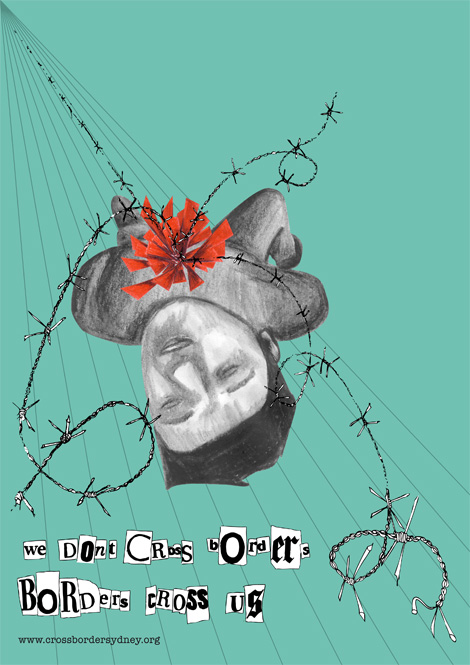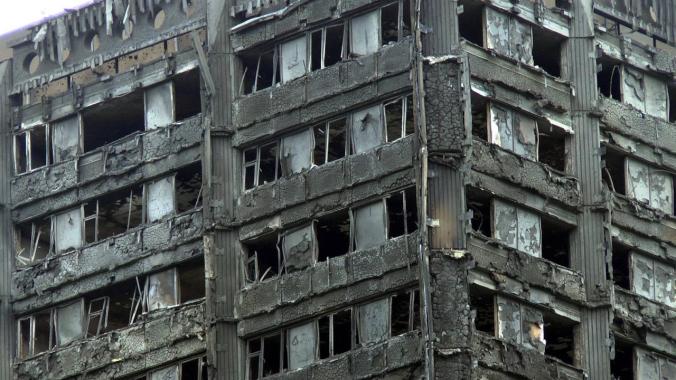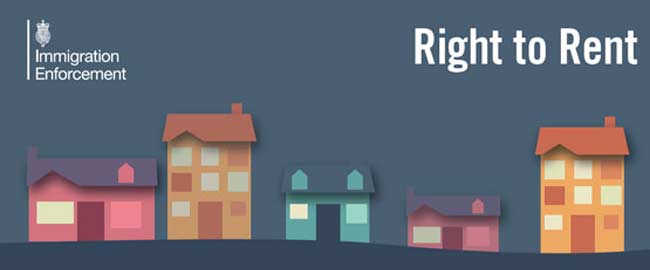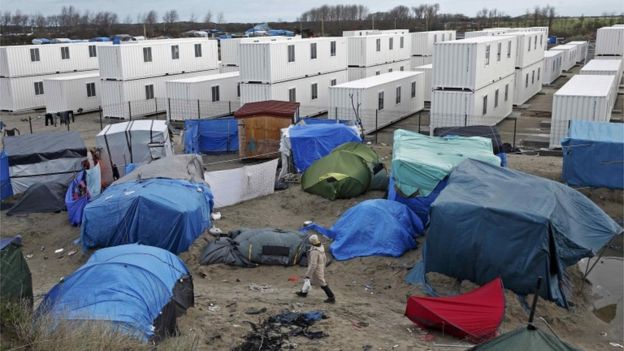This is a guest post by Sarah Keenan, who is a Lecturer in Law at Birkbeck, University of London. Keenan is the author of Subversive Property: Law and the Production of Spaces of Belonging, as well as numerous articles in the fields of property law, critical race theory, gender and sexuality, migration, and the politics of Indigenous Australia.
 Two summers ago, the British government announced that it would pass laws requiring landlords to evict tenants who do not hold valid visas. As part of her efforts to convince poor African migrants that ‘our streets are not paved with gold‘, then Home Secretary Theresa May planned to make it a criminal offence for landlords to rent to irregular migrants. This plan, which has since been implemented by the Immigration Act 2016,[1] was part of May’s professed intention of intensifying the ‘hostile environment‘ for irregular migrants that her government had begun creating with the Immigration Act 2014. As the Church of England put it, the so-called ‘right to rent’ requirement creates a border in every street.
Two summers ago, the British government announced that it would pass laws requiring landlords to evict tenants who do not hold valid visas. As part of her efforts to convince poor African migrants that ‘our streets are not paved with gold‘, then Home Secretary Theresa May planned to make it a criminal offence for landlords to rent to irregular migrants. This plan, which has since been implemented by the Immigration Act 2016,[1] was part of May’s professed intention of intensifying the ‘hostile environment‘ for irregular migrants that her government had begun creating with the Immigration Act 2014. As the Church of England put it, the so-called ‘right to rent’ requirement creates a border in every street.
How do we understand such borders, which are at once invisible and real, intermittent and permanent; borders that operate by attaching to individual subjects wherever they go rather than bounding off a defined physical area; borders that are internal to the nation that has already been entered. In particular, how do we understand internal borders in Britain, a political entity that as Kojo Koram has argued, ‘has never really existed as a nation, it has only really functioned as an empire‘; an empire which once sought to extend its borders to encompass as much of the world as possible? As the empire crumbled, patterns of migration shifted from white British subjects moving out to colonise the world, to brown and black British subjects moving from resource-depleted home countries to the island motherland, seeking work and a better life. The British state responded to this arrival of non-white subjects with increasingly restrictive immigration laws which have the maintenance of white supremacy at their core. Immigration law has then combined with other areas of law to increasingly and literally restrict the physical space in which non-white subjects are able to safely exist on this island. Examining the hostile environment produced by the internal borders of the 2014 and 2016 Immigration Acts helps us to make sense of the means through which law produces racist landscapes in which material spatial boundaries exist for particular subjects and not others. Beginning with a brief discussion of how legal geography, critical race theory and critical disability studies assist in understanding the relationship between law, space and the human subject, I put forward the concept of ‘taking space with you’ as a way to understand the racist British landscape in which we live today.
‘We don’t cross borders, borders cross us’
The liberal democratic state, and the law it creates, are underpinned and legitimised by notions of universality and neutrality – theoretically, law delivers justice to all subjects on an equal basis. Critical race and feminist theorists have long noted the flaws in this theorisation, demonstrating ways in which law operates unevenly depending on who you are.[2] More recently, legal geography has also demonstrated ways in which law operates unevenly depending on where you are.[3] Legal geography, critical race and feminist theorists have argued that law falsely constructs spaces as being politically neutral, uniform and fixed. They instead argue that space in fact consists of multiple, dynamic realities; realities which affect different people in different ways. Here I always find geographer Doreen Massey’s work useful. Instead of thinking of places as bounded areas, Massey imagines them as ‘articulated moments in networks of social relations and understandings’.[4] Because the same moment will be experienced and articulated differently by different people, this understanding accounts for the same place having mismatched and even contrasting meanings for different people. The place that is ‘the British Border’ at Heathrow Terminal 4 airport on any given day, for example, is a familiar workplace for UK Border Agency officers, a congested but still fast-moving queue for EU-passport holders, and a very physical barrier – a place of life and death – for a refugee who has just landed with the hope of being granted asylum. Before the fire, the place that was Grenfell Tower was a home to the hundreds of primarily brown and black families who lived there, an eyesore to be managed until it could be ‘regenerated’ as cheaply as possible for Kensington and Chelsea Borough Council, and an irritant to quite literally be covered up – in cheap, flammable cladding – for Kensington and Chelsea Tenant Management Organisation, the landlord which for many years ignored the repeated pleas of residents to improve the building’s fire safety mechanisms. Places mean different things to different people depending on how they are socially and physically located.

poster design: Judita Invisible
Thinking about space as multiple in meaning and constantly in motion also allows for spatial entities such as nation-states to be understood beyond their bounded physical landmass. Nation-state borders are not simple lines of demarcation, but complex institutions.[5] As Anderson, Sharma and Wright argued (over a decade before ‘hostile environment’ became government policy), ‘borders follow people and surround them as they try to access paid labour, welfare benefits, health, labour protections, education, civil associations and justice’.[6] As Sydney activist group Cross Border Collective put it, following Chicana feminist theorists such as Gloria Anzaldua, ‘we don’t cross borders, borders cross us’.
The space you take with you
One way to understand the complicated connection between human subjects and the places we live in and move through is the idea of ‘taking space with you’: that we take a particular space with us when we move. This idea requires that we take seriously the meanings and consequences which attach to particular spaces and to those constructed as belonging to them. Within the contemporary English landscape, for example, the space of ‘the tower block’ has particular meanings and consequences: it means poor, over-crowded, migrant, socially immobile, working class, racialised, ghetto; and its consequences are government and corporate containment and malicious neglect, particularly as these spaces of poverty become blights on a rapidly gentrifying landscape, bringing down property prices and getting in the way of ‘regeneration’. Belonging to the space of the tower block means having a materially lower than average standard of living and an identity that will not be listened to or taken seriously by those in power, even when – as the Grenfell Action Group blog shows us – it is a matter of life and death. Belonging to a tower block means you are likely to be racialised. As Danny Dorling’s research shows, most children who live above the 4th floor of tower blocks in England are black or Asian.[7] All human subjects are intimately connected to, and to an extent defined by, the spaces where we live. Who we are, what is within our reach, and our vulnerability to violence is constantly (re)determined by where we have been and what has happened around us. As Donna Haraway suggested in the early 90s, our bodies do not end at the skin.[8] Critical disability scholar Margaret Shildrick argues that in fact we humans are all hybrids – combining with, separating from and being both enabled and obstructed by physical environments in different ways.[9] There is no purely organic, bounded embodied human subject who lives in isolation from others and from space.

So space attaches to us all, we combine with it and it defines who we are and what we can access. Race, gender, ability and other categories of belonging materialise, on an individual level, through intimate interactions between space and the body. There is no doubt that coming from a particular part of the world operates as a signifier of racial difference. So too can living in a particular part of London. Wearing particular kinds of clothing or consuming particular kinds of food can operate as signifiers of racial difference, even though clothes, food and places are not part of the body, but exist in the space beyond it.[10] Sara Ahmed argues that racism can operate as a ‘brick wall’ that has been built up by history, a wall that can appear in different places and times, but only in front of particular subjects, preventing them from accessing resources or simply continuing their journeys.[11] The brick wall of racism is a space that many subjects take with them as they move, whether the journey is across the world or across the road. Race is a social construct originating in European colonialism, but it is reproduced on a pervasive and daily basis by laws and norms that restrict the physical space particular subjects can safely occupy, thus obstructing their life paths. The category of race and the racist landscapes that maintain it are produced through the repeated operation of ‘brick walls’ which obstruct particular journeys and let subjects know they do not belong.
The Immigration Acts 2014 and 2016: Building Internal Borders
The Immigration Acts of 2014 and 2016 introduce a scheme of regulation which creates a landscape in which a subject’s immigration status acts as a physical barrier to basic needs including housing. The Acts produce a landscape of bespoke hostility to migrants and those seen as non-British by regulating the behaviour of landlords. While a subject’s visa status has traditionally been checked at the territorial entrance point, the Act introduces a range of ‘in-country’ immigration status checks, meaning that those who provide not only housing but also banking services, drivers’ licences and marriage certificates will be required to check the immigration status of applicants before providing them with the relevant service/access. While British universities have been acting as UKBA proxies since at least 2012, the new Acts extend the internal border regime well beyond higher education to everyday services necessary for human survival. Those who tend to come up against the ‘brick wall’ of passport and visa checks at the territorial entrance point, must now expect to come up against that brick wall wherever they attempt to rent a home in England.

Using spatial metaphors, human rights group Liberty describes the new immigration checks as ‘gateway requirements’’ for access to basic services. The Asylum Support Appeals Project described them as ‘hurdles’. And it was the Church of England which predicted that the Act would create ‘a border in every street’. But the in-country ‘gateways’ and ‘borders’ that these groups refer to are, like Sara Ahmed’s ‘brick walls’, not only metaphorical. For subjects who have had their claims for asylum rejected, who have overstayed their visas or who for other reasons do not have either EU citizenship or a valid British visa, these regulations constitute material barriers to physical spaces. Bureaucratic ‘brick walls’ serve the same exclusive purpose as physical ones.
But which subjects exactly will be met with a border on every street? How does the Act build a specifically racist landscape? British immigration law has a long history of operating as a ‘brick wall’ for particular subjects, and producing categories of race in the process. As Nadine El-Enany explains, in an attempt to keep the crumbling empire together, the British Nationality Act was passed in 1948. It granted all nationals of Commonwealth countries and British colonies British citizenship – meaning that there were some 600 million British citizens, all of them with rights of entry to Britain itself. When non-white British citizens began arriving in Britain throughout the 1950s and 60s, increasingly restrictive immigration legislation was passed to limit their presence. The Immigration Act 1971 restricted the right to enter and remain in Britain to those whose parents or grandparents were born in Britain. While not framed in explicitly racist language, the law had explicitly racist motives. Coming on the heels of white supremacist Enoch Powell’s rivers of blood speech and growing racist and xenophobic sentiment among British voters, the Act made it more difficult for non-white British subjects to come to Britain. Unless they had the requisite bloodline to Britain stretching back to a time when the motherland was overwhelmingly white, citizens of Britain’s remaining colonies and those of Commonwealth countries had to apply for permission to be cleared to enter Britain. The 1971 Act thus constructed an initial ‘brick wall’ for some British subjects, constituting them as a racial category in the process. This wall operated at or before the point of entry into the actual British landmass.
Entry clearance requirements impose an administrative border on subjects born in particular places, a border that extends all the way into their home states and areas they might pass through on the journey to Britain. The extension of the border well outside Britain’s physical boundaries has been referred to as the ‘external border’,[12] and might also be understood as Ahmed’s brick wall of racism, a wall that appears in the path of particular subjects before they have even left their homes. The operation of the British external border in Calais[13] for example enables British border officers to prevent people from coming to Britain well before they reach British territory. The external borders of Britain and other EU countries are policed by FRONTEX, which effectively enforces EU borders in locations across the world but most notably in the Mediterranean and along the northern and western African coast were boats might attempt to enter EU territorial waters. Tens of thousands of people have died trying to cross the EU’s external borders.

While provisions from the 1971 Immigration Act to FRONTEX produce an external British border, the new Immigration Act 2016 produces internal borders for Britain. The internal and external British borders are driven by racist colonial anxieties, and are reproductive of racial categories. Race, as Stuart Hall argued, is a moving signifier – who is ‘white’ and who is racially other is not natural or permanent but shifts over time (the altered status of EU migrants in Britain, Poles in particular, post-Brexit referendum, is one example of a recent shift away from whiteness). Categories of race are reproduced through material structures of racism, from the extreme impoverishment of former British colonies to the everyday acts of discrimination endured by individuals designated as belonging to those colonies. A young Igbo woman having spent her life in Nigeria may not see herself as ‘black’, but she will once she encounters the British border. If she is fortunate enough to pass the external border she will then encounter the internal one every time she tries to rent a flat (or open a bank account or get a driver’s licence). Every interaction with the internal border is productive of her understanding of herself as foreign, and of the British landscape as a white supremacist environment.
The space that the irregular migrant takes with her as she travels both toward and within Britain is a process of constant negotiation with borders. This process not only determines the subject’s identity but also literally restricts the physical spaces in which she can safely exist. Her body does not end at the skin because a border appears before her at every turn. She becomes an embodied hybrid of human and border control. She takes the space of racist colonial exclusion with her wherever she moves.
And that space does not move only with her. Many predicted that landlords will simply opt to rent to tenants with English-sounding names, so as to avoid the risk of contravention and the need to do extra paperwork, and a 2017 report by the Joint Council for the Welfare of Immigrants confirmed this to be the reality. As well as creating a ‘hostile space’ for irregular migrants, the combining of private property and border controls produces a national space in which all non-white subjects (or at least those who lack the enormous wealth required to buy their own property and thus escape the rental market) are likely to be spatialised as aliens, taking a space of exclusion and vulnerability with them wherever they go.
As Jon Burnett argues, the aim of the Immigration Act is to make life intolerable for undocumented migrants so as to force them to leave – their destitution is used as a government tool of deportation. The internalisation of the border through right to rent requirements thus bolsters the white supremacist landscape of contemporary Britain, creating a physical environment in which racialised subjects take the violence of colonial anxieties and brick walls with them, in every street.
Looking forward in the wake of Grenfell
In the faces of the Grenfell dead and missing we can see that the internal border was in operation in London’s richest borough. The burnt out remains of the block and the haunting screams of those who perished in panic and agony surely function for Theresa May as an unmistakably clear communication of her message to poor African migrants that ‘our streets are not paved with gold’. Not for them. The right to rent requirements of the 2014 and 2016 Immigration Acts serve to bolster the hostile environment that 40 years of housing policy and close to a century of exclusionary citizenship policy have already produced for poor, non-white migrants and their children. The first confirmed victim was Mohammad Alhajali, a 23-year old Syrian refugee and engineering student. He lived in the tower with his 25-year old brother, who survived. As Alhajali’s friend told the Telegraph, ‘He survived Assad, the war in Syria, only to die in a tower block in London.’ The images of Grenfell on fire are reminiscent of the many burnt out building shells in Syria that we are shown by the media. What happened to Mohammed was for me the most horrific demonstration of the taking space with you idea: a space of disproportionate vulnerability to the most extreme forms of violence, which Mohammad Alhajali took with him all the way from Syria to Kensington.

The British landscape we live in today is not fixed in time. We need a multiplicity of campaigns and tactics to tackle the multiplicity of racist spaces which law and history have produced: because we are hybrids, and because law racially excludes not only through immigration law but also through property and administrative law, it is this endemic and structural racism embedded everywhere that we need to fight. Campaigns for human rights (framed as if our bodies end at the skin) are not enough. We need to also fight for housing, universal healthcare and education, transparency and accountability in university management and other government institutions, in order to not only empower individual human subjects but to reshape the environment that surrounds and defines them, and to build a version of Britain that allows the subjects of empire and their children to finally leave the heinously resilient and sticky space of white supremacist violence behind.
[1] Section 39 of the Immigration Act 2016 amends the Immigration Act 2014, inserting s33A which creates the offence.
[2] Bell, Derrick. Race, Racism, and American Law. Aspen Publishers 1970; MacKinnon, Catharine A. “Feminism, Marxism, Method, and the State: Toward Feminist Jurisprudence.” Signs: Journal of women in culture and society 8, no. 4 (1983): 635-658.
[3] The Legal Geographies Reader: Law, Power and Space. Edited by Nicholas Blomley, David Delaney and Richard T Ford. Oxford: Blackwell, 2001.
[4] Massey, Doreen. “Politics and Space/Time.” In Place and the Politics of Identity. Edited by Michael Keith and Steve Pile. London, Routledge 1993: 141-160.
[5] Balibar, Etienne. Politics and the Other Scene. London, Verso 2002: 84-86.
[6] Anderson, Bridget , Nandita Sharma, and Cynthia Wright. ‘Editorial: Why No Borders?’ Refuge Vol. 26, No. 2 (2009) 5-18.
[7] Dorling, Danny. So You Think You Know About Britain? Hachette UK, 2011.
[8] Haraway, Donna. “A Cyborg Manifesto: Science, Technology, and Socialist-feminism in the Late Twentieth Century.” Simians, cyborgs and women: the reinvention of nature (1991): 149-181.
[9] Shildrick, Margrit. “Why Should Our Bodies End at the Skin?: Embodiment, Boundaries, and Somatechnics.” Hypatia 30, no. 1 (2015): 13-29.
[10] Lentin, Alana. Racism: A Beginner’s Guide. London, Oneworld Publications 2012.
[11] Ahmed, Sara. On Being Included: Racism and Diversity in Institutional Life. Duke University Press, 2012.
[12] Van Houtum, Henk. “Human Blacklisting: The Global Apartheid of the EU’s External Border Regime.” Environment and Planning D: Society and Space 28, no. 6 (2010): 957-976.
[13] Under the Sangette Protocol agreed in 1991 between Britain and France.
Thanks for your illuminating piece Sarah.
But it’s not quite true to say that Commonwealth citizens were free to come and go until the 1971 Act – the Commonwealth Immigrants Act 1962 first imposed controls on them, while it was the 1968 CIA which pioneered the concept of partiality, by subjecting to immigration control UK and Colonies citizens who got their citizenship through connection with a colony rather than an ancestral connection with the UK. The 1971 Act consolidated and built on these changes.
LikeLike
Pingback: Britain’s shame – Harold Sterling